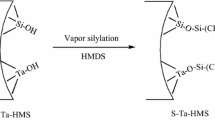Abstract
A novel methyl-rich Ti-containing hexagonal mesoporous silica (Ti-HMS) molecular sieve with high hydrophobicity has been prepared by a two-step method involving co-condensation followed by vapor-phase methyl grafting. The sample was characterized by XRD, N2 adsorption, FTIR, UV-visible and 29Si NMR spectroscopies, TG, ICP-AES, and hydrophilicity measurements, and its catalytic performance was evaluated using the epoxidation of cyclohexene as a probe reaction. The Ti-HMS material retains a typical mesoporous structure and compared with a co-condensed Ti-HMS prepared in a one-step method possesses more methyl groups and higher hydrophobicity, and also exhibits better catalytic activity and selectivity.
Similar content being viewed by others
References
Kresge CT, Leonowicz ME, Roth WJ, Vartuli JC, Beck JS. Ordered mesoporous molecular sieves synthesized by a liquid-crystal template mechanism. Nature, 1992, 359: 710–712
Tanev PT, Chibwe M, Pinnavaia TJ. Titanium-containing mesoporous molecular sieves for catalytic oxidation of aromatic compounds. Nature, 1994, 368: 321–323
Zhao DY, Feng JL, Huo QS, Melosh N, Fredrickson GH, Chmelka BF, Stucky GD. Triblock copolymer syntheses of mesoporous silica with periodic 50 to 300 angstrom pores. Science, 1998, 279: 548–552
Corma A. From microporous to mesoporous molecular sieve materials and their use in catalysis. Chem Rev, 1997, 97: 2373–2420
Wang YJ, Wang XL, Xie GQ, Lu JQ, Jin WY, Liu XJ, Luo MF. Crotonaldehyde hydrogenation over CuO/SBA-15 catalyst (in Chinese). J Catal, 2008, 29: 482–488
Hou DM, Zhou F, Li X, Wang LY, Wang AJ. Hydrodesulfurization performance of MCM-41 supported Pd catalysts (in Chinese). Acta Petrolei Sinica (Petroleum Processing Section), 2009, 25: 167–172
Peña ML, Dellarocca V, Rey F, Corma A, Coluccia S, Marchese L. Elucidating the local environment of Ti(IV) active sites in Ti-MCM-48: A comparison between silylated and calcined catalysts. Micropor Mesopor Mater, 2001, 44–45: 345–356
Marchese L, Maschmeyer, T, Gianotti E, Coluccia S, Thomas JM. Probing the titanium sites in Ti-MCM-41 by diffuse reflectance and photoluminescence UV-vis spectroscopies. J Phys Chem, 1997, 101: 8836–8838
Li KT, Lin PH, Lin SW. Preparation of Ti/SiO2 catalysts by chemical vapor deposition method for olefin epoxidation with cumene hydroperoxide. Appl Catal, 2006, 301: 59–65
Melero JA, Grieken R van, Morales G. Advances in the synthesis and catalytic applications of organosulfonic-functionalized mesostructured materials. Chem Rev, 2006, 106: 3790–3812
Igarashi N, Kidani S, Ahemaito R, Hazuhito H, Tatsumi T. Direct organic functionalization of Ti-MCM-41: Synthesis condition, organic content, and catalytic active. Micropor Mesopor Mater, 2005, 81: 97–105
Cagnoli MV, Casuscelli SG, Alvarez AM, Bengoa JF, Gallegos NG, Crivello ME, Herrero ER, Marchetti SG. Ti-MCM-41 silylation: Development of a simple methodology for its estimation—Silylation effect on the activity and selectivity in the limonene oxidation with H2O2. Catal Today, 2005, 107–108: 397–403
Lin KF, Wang LF, Meng FY, Sun ZH, Yang Q, Cui YM, Jiang DZ, Xiao FS. Formation of better catalytically active titanium species in Ti-MCM-41 by vapor-phase silylation. J Catal, 2005, 235: 423–427
Tuel A. Modification of mesoporous silicas by incorporation of heteroelements in the framework. Micropor Mesopor Mater, 1999, 27: 23–33
Sever R R, Alcala R, Dumesic J A, Root T W. Vapor-phase silylation of MCM-41 and Ti-MCM-41. Micropor Mesopor Mater, 2003, 66: 53–67
Bhaumik A, Tatsumi T. Organically modified titanium-rich Ti-MCM-41, efficient catalysts for epoxidation reactions. J Catal, 2000, 189: 31–39
Müller CA, Maciejewski M, Mallat T, Baiker A. Organically modified titania-silica aerogels for the epoxidation of olefins and allylic alcohols. J Catal, 1999, 184: 280–293
Zhang MY, Wang LF, Huang ZT. Synthesis conditions and catalytic performance of hexagonal mesoporous silica containing copper (in Chinese). J Catal, 2003, 24: 914–918
Author information
Authors and Affiliations
Corresponding author
Rights and permissions
About this article
Cite this article
Li, X., Xu, Z., Gao, H. et al. Preparation, characterization, and catalytic performance of a novel methyl-rich Ti-HMS mesoporous molecular sieve with high hydrophobicity. Sci. China Chem. 53, 1337–1345 (2010). https://doi.org/10.1007/s11426-010-3188-8
Received:
Accepted:
Published:
Issue Date:
DOI: https://doi.org/10.1007/s11426-010-3188-8



